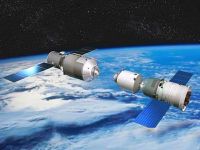Difference between revisions of "Tiangong 1"
imported>Ciic |
imported>Ciic |
||
| Line 1: | Line 1: | ||
[[file: Tiangong-1.JPEG|thumb|200px|left|Tiangong-1]] | [[file: Tiangong-1.JPEG|thumb|200px|left|Tiangong-1]] | ||
| − | '''Tiangong-1''' (Chinese:天宫一号) is an unmanned space module complex launched by [[China]] as it | + | '''Tiangong-1''' (Chinese:天宫一号) is an unmanned space module complex launched on September 29, 2011 by [[China]] as it builds the country's first space station. In preparation for the space station construction, Tiangong-1 will dock with with three spaceships, the Shenzhou 8, Shenzhou 9 and Shenzhou 10, respectively, to form the space station, also known as Project 921-2. |
The name "Tiangong", literarily translated as Heavenly Palace, symbolizes Chinese people' centuries-long dream of exploring outer space. The name references Wu Cheng'en's "Journey to the West," one of the Four Great Classical Novels of Chinese literature. | The name "Tiangong", literarily translated as Heavenly Palace, symbolizes Chinese people' centuries-long dream of exploring outer space. The name references Wu Cheng'en's "Journey to the West," one of the Four Great Classical Novels of Chinese literature. | ||
Revision as of 02:21, 30 September 2011
Tiangong-1 (Chinese:天宫一号) is an unmanned space module complex launched on September 29, 2011 by China as it builds the country's first space station. In preparation for the space station construction, Tiangong-1 will dock with with three spaceships, the Shenzhou 8, Shenzhou 9 and Shenzhou 10, respectively, to form the space station, also known as Project 921-2.
The name "Tiangong", literarily translated as Heavenly Palace, symbolizes Chinese people' centuries-long dream of exploring outer space. The name references Wu Cheng'en's "Journey to the West," one of the Four Great Classical Novels of Chinese literature.
Functioning as a target spacecraft, Tiangong-1 is expected to become China's first space laboratory when it connects to the above mentioned spaceships.
The target spacecraft is composed of two parts. One module is intended for space experiments while the other serves as a "resources module", providing fuel for the regular orbits.
The Tiangong-1 was scheduled to lift off from Jiuquan Satellite Launch Center in Inner Mongolia in early September 2011. However, its launch was delayed due to the country's previous failure to send the SJ-11-04 satellite into space. The satellite's carrier rocket CZ-2C is from the same family as the CZ-2F rocket which propels Tiangong-1 into orbit.
Despite the delays, a spokesman from the China Manned Space Engineering Project said the tests of Tiangong-1 and its CZ-2F carrier rocket continue to go smoothly.
During its two-year service, the 8.5-ton Tiangong-1 will receive several astronauts who will man the Shenzhou 9 and Shenzhou 10 crafts. According to space technologist Qi Faren, the docking technology is pivotal to the Tiangong Program/Project 921-2.
